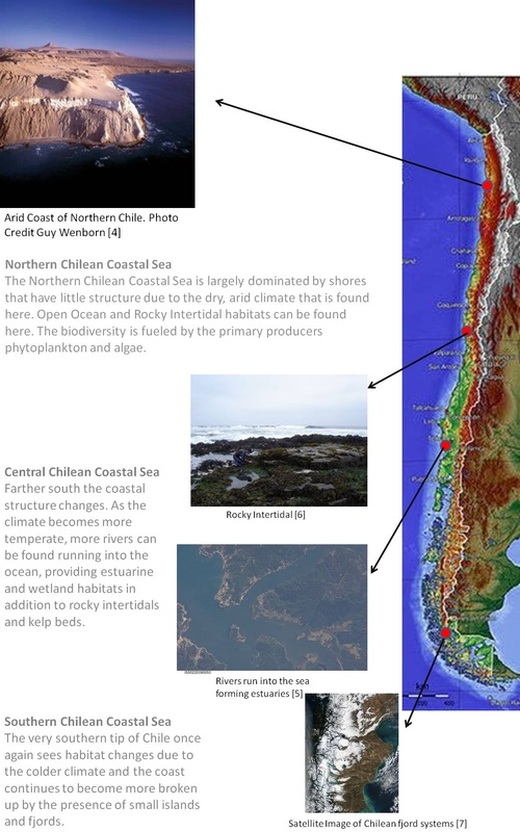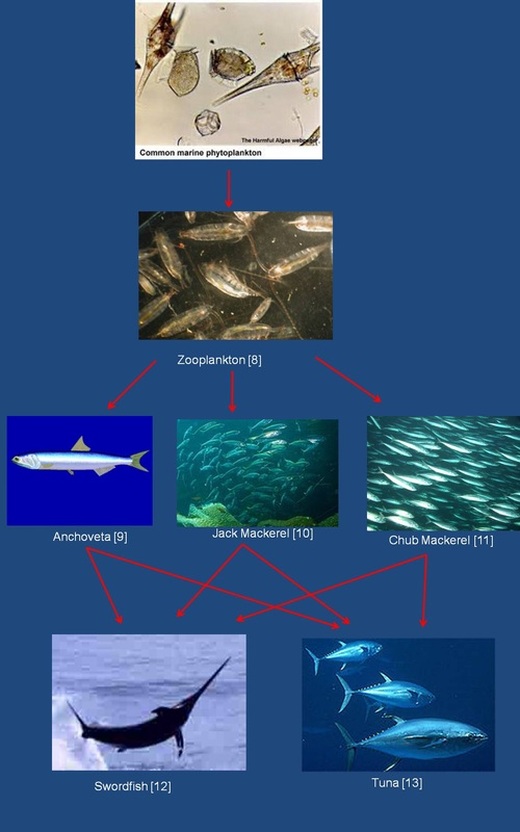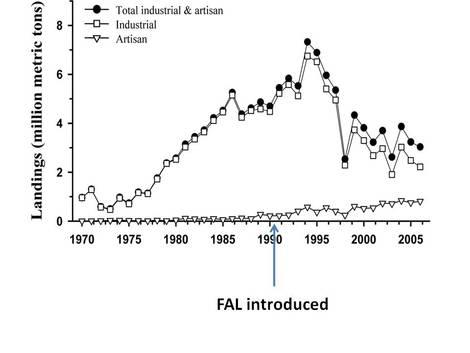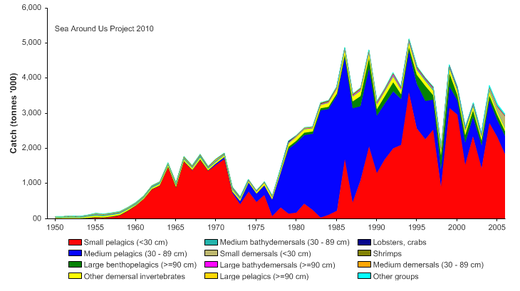Chilean Coastal Sea
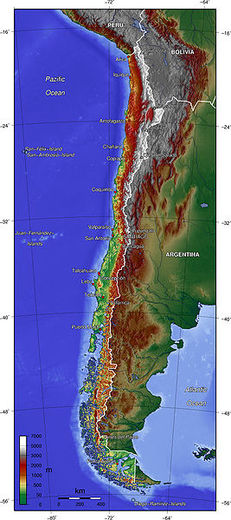
The Chilean Coastal Sea [1]
The Chilean Coastal Sea is the area in the Southeastern Pacific Ocean that runs along the length of Chile in South America. Considering that Chile itself is 4,270 km long, its coastal habitats encompass a large variety of habitats and ecosystems, in addition to its open ocean habitat.
The Chilean Coastal Sea supports one of the most productive fisheries in the world, and until recently was also one of the top producers of farmed salmon. These fisheries are supported by one of the largest upwelling events in the world due to the Humboldt Current.
Contents
1.Basic information
2.Biodiversity
3.Food webs and major organisms
4.Historical use of region
5.How fisheries are managed
6.Major fisheries
7. Habitat change
8. Pollution
9. Issues specific to the Chilean Sea
10. Solutions
11. References
The Chilean Coastal Sea supports one of the most productive fisheries in the world, and until recently was also one of the top producers of farmed salmon. These fisheries are supported by one of the largest upwelling events in the world due to the Humboldt Current.
Contents
1.Basic information
2.Biodiversity
3.Food webs and major organisms
4.Historical use of region
5.How fisheries are managed
6.Major fisheries
7. Habitat change
8. Pollution
9. Issues specific to the Chilean Sea
10. Solutions
11. References
Basic Information
Coastal Chile
The coast of Chile has a fairly wide range of habitats laid out in a somewhat linear fashion. Starting in Northern Chile, the coast is mostly dry desert, with cliffs along the coast and little protection from the waves. Heading south, more rivers drain to the ocean and the climate becomes more temperate, leading to a more "broken up" coast that contains wetlands and estuaries. Head even farther south and small islands and fjords become a common site.
The coast of Chile has a fairly wide range of habitats laid out in a somewhat linear fashion. Starting in Northern Chile, the coast is mostly dry desert, with cliffs along the coast and little protection from the waves. Heading south, more rivers drain to the ocean and the climate becomes more temperate, leading to a more "broken up" coast that contains wetlands and estuaries. Head even farther south and small islands and fjords become a common site.
Peru Chile Trench
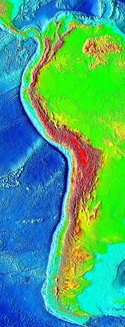
Peru-Chile Trench (dark blue line along the coast) [2]
The Peru-Chile Trench is about 160 km off of the western coast of South America. It spans a length of roughly 5,900 km that stretches from Peru in the north to about halfway down Chile's coast in the South. It has a maximum depth of 8,065 meters and an average width of 64 km. The trench was formed by the subduction of two plates along the coast, which also makes it an active area for earthquakes which have been attributed to changing some coastal habitats such as the Carlos Anwandter Nature Sanctuary.
The trench is also an area of active research on deep sea communities. Due to high amounts of primary production on the surface via the Humboldt Current, more nutrients are able to make their way down to sea floor within the trench and they support an abundance of life, from bacterial mats to tiny invertebrates, with more life and deep sea vents hypothesized to occur there.
The trench is also an area of active research on deep sea communities. Due to high amounts of primary production on the surface via the Humboldt Current, more nutrients are able to make their way down to sea floor within the trench and they support an abundance of life, from bacterial mats to tiny invertebrates, with more life and deep sea vents hypothesized to occur there.
Humboldt Current System (HCS)
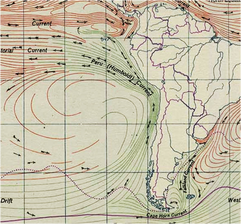
The direction of the HCS along the coast of Chile [3]
The Humboldt Current System (HCS) is the largest upwelling system in the world. In the summer, upwelling favorable conditions bring in cold, nutrient rich waters that flow in from southern Chile north to Peru. This increase in nutrients generates a large amount of primary productivity and supports a very productive ecosystem from Central to Northern Chile.
During El Nino Southern Oscillation (ENSO) events, this upwelling of cold waters is reduced as atmospheric conditions change (Southern Trade Winds slack or reverse direction) and warmer waters flow back eastward along the equator southwards along the coast. This results in a decrease in primary productivity that impacts the entire foodweb, shifting species structure and populations and hurting the commercial fishing industry.
During El Nino Southern Oscillation (ENSO) events, this upwelling of cold waters is reduced as atmospheric conditions change (Southern Trade Winds slack or reverse direction) and warmer waters flow back eastward along the equator southwards along the coast. This results in a decrease in primary productivity that impacts the entire foodweb, shifting species structure and populations and hurting the commercial fishing industry.
Biodiversity
Habitats
Due to its length and the various climates that the Chilean Coast encompasses, the Chilean Coastal Sea has a wide range of habitats in addition to its open ocean.
Due to its length and the various climates that the Chilean Coast encompasses, the Chilean Coastal Sea has a wide range of habitats in addition to its open ocean.
Food Webs and Major Organisms
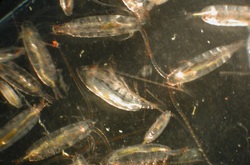
Phytoplankton fuels copepod (above) production [8]
Primary Food Web and its Major Organisms
The main food web that is found in the Chilean Coastal Sea is established by the Humboldt Current System (HCS). The cold, nutrient rich waters that move in support a large increase in phytoplankton biomass, which are the main primary producers within this food web. Zooplankton consume these phytoplankton which are then in turn consumed by the anchoveta, sardine, and chub and jack mackeral, which all make up the dominant species within this food web. Anchoveta fisheries are an important economic source of income for Chile, and they are also prey for highly migratory fishes such as tuna and swordfish. The production of the HCS and the organisms that it provides for are highly affected by the El Nino Southern Oscillation (ENSO) events. The colder nutrient rich waters are replaced by warmer nutrient poor waters during these years and the effects are apparent. Fish numbers and ranges may shift drastically, and increased sardine numbers replace the depleted anchoveta stocks. However, it has been suggested that these are fairly short term effects as recovery from El Nino events has tended to be relatively quick.
The main food web that is found in the Chilean Coastal Sea is established by the Humboldt Current System (HCS). The cold, nutrient rich waters that move in support a large increase in phytoplankton biomass, which are the main primary producers within this food web. Zooplankton consume these phytoplankton which are then in turn consumed by the anchoveta, sardine, and chub and jack mackeral, which all make up the dominant species within this food web. Anchoveta fisheries are an important economic source of income for Chile, and they are also prey for highly migratory fishes such as tuna and swordfish. The production of the HCS and the organisms that it provides for are highly affected by the El Nino Southern Oscillation (ENSO) events. The colder nutrient rich waters are replaced by warmer nutrient poor waters during these years and the effects are apparent. Fish numbers and ranges may shift drastically, and increased sardine numbers replace the depleted anchoveta stocks. However, it has been suggested that these are fairly short term effects as recovery from El Nino events has tended to be relatively quick.
a
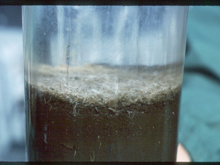
Core sample from deep sea-floor showing bacterial mat []
The large increase in primary productivity via phytoplankton and waste products each year also help to support a deep sea benthic community. Research is relatively new in this area, but early studies have shown that the nutrients that are filtered down to the sea floor do in fact support a range of species, from microbial mats to invertebrates.
Historical Use
Historically the Chilean Coastal Sea was not heavily used. The indigenous peoples that lived in Chile mainly used canoes to navigate rivers and lakes within the mainland of Chile. However, after Chile's Independence in 1818, the economy was largely based around agriculture and mining, with various ports located along its coast. The coast does have a history of artisanal fisheries, with subsistence fishing dominating, but it wasn't until around the 1970's that Chilean fisheries greatly expanded and began using the sea to help drive Chile's economy forward.
How Fisheries are Managed
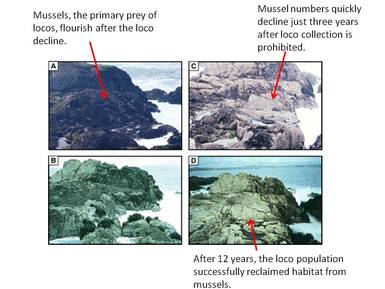
Leading up to the establishment of Exclusive Economic Zones in 1984, Chile had gone through a regime change in their government and were fully ready to take advantage of their newly established oceanic region. The government deregulated the fishing industry which led to a relatively large expansion within that sector, and thus a significant increase in profits. Some of the changes included privatization of the industry, getting rid of a permit based system for pelagic stocks, and limiting foreign fishing activity. Chile quickly became the largest exporter of fish in South America, and by the late 1980's was starting to show signs of over-fishing. There were few regulations and the long coastline made it harder to enforce these regulations. These factors coupled with the incentive to make a profit led many individuals to continue to exploit the oceans, namely the coastal habitats since they were easily accessible. This drive for individual profits over long term sustainability ultimately led to a crash of the loco, a highly profitable carnivorous gastropod found in rocky intertidal habitats. This crash led to a change in the species composition where the loco had been over-exploited and raised awareness for sustainability as well as a call for regulation reform. Extraction of locos became illegal in 1989 and the increased awareness of other declining fish populations led to the Fisheries and Aquaculture Law (FAL) in 1991.
Current Regulations
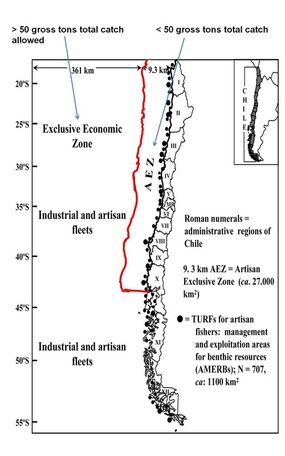
There was a relatively dramatic shift in the management and zoning rights of fisheries with the passing of the FAL in 1991. It recognized two types of fisheries, commercial and artisanal. Commercial fleets could have multiple vessels and a catch that exceeded 50 tons. These vessels are required to pay a fixed fee in addition to renewing a license each year, which are given out in limited numbers. Artisanal fleets are mostly small scale subsistence fisheries and their vessels have a maximum length of 18 m. and a combined catch of no more than 50 tons. Notably, it established an exclusive zone for artisanal fisheries (AEZ) that extended roughly 9.3 km from the coast that commercial fisheries could not fish in. This is important because the coastal shelf is largely encompassed within this zone and is an area with a high amount of upwelling and thus small pelagic fish tend to congregate there. Recently, total catches have leveled off and remained relatively stable although there has been a steady increase in artisanal catches since the introduction of the FAL, as well as a steady decrease in commercial fisheries catch as of late.
Another unique management plan that was created established territorial usage rights for fisheries (TURFs). These TURFs give even more exclusive rights to very small scale fisheries to fish benthic species near the coast. This was established in response to increasing exploitation of benthic species within nearshore communities.
Another unique management plan that was created established territorial usage rights for fisheries (TURFs). These TURFs give even more exclusive rights to very small scale fisheries to fish benthic species near the coast. This was established in response to increasing exploitation of benthic species within nearshore communities.
The implementation of the FAL is considered to be a step towards better sustainability and protection of fisheries. Each fishing vessel or TURF fisherman must be registered to fish within their region, sometimes through a union that monitors the fishing practices. Keeping track of how many fisheries there are and what they are harvesting is surely a step in the right direction towards the sustainability of fishes.
Major Fisheries
Currently, the major fisheries in Chile are based on small pelagic fish. The anchoveta is the dominant fishery and is largely used to create fishmeal. However it is subject to population crashes during El Nino Southern Oscillation events. During these events, there is less upwelling from the Humboldt Current and thus less nutrients. This leads to a loss of the primary producing phytoplankton and has effects on the entire foodweb from the bottom up, causing major declines in the anchoveta fisheries.
Other important species include the jack and chub mackerel, sardines, and herring. These species, including the anchoveta, are primarily caught using purse seines.
Other important species include the jack and chub mackerel, sardines, and herring. These species, including the anchoveta, are primarily caught using purse seines.
Aquaculture
In the early 1980's the farming of salmon was brought to Chile as a means for Chile to expand its economy beyond copper exports. The Chilean fjord systems in southern Chile were ideal habitats for aquaculture due to the colder temps needed for raising salmon, protection from damaging storms, good nutrient flows, and the freshwater habitats necessary for raising salmon. There was also a global market since all of the salmon production was based in the northern hemisphere and could only produce salmon for part of the year. Due to Chile being in the southern hemisphere, they could potentially fill that production gap because of the alternating seasons.
a
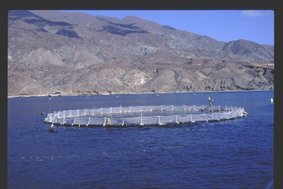
Aquaculture Cage [14]
Aquaculture quickly took off and similar to the commercial catch fisheries, few regulations were implemented or enforced. The governing agencies were unable to keep up with the exponential growth and production, making many regulations outdated and in need of revision. Even then, farmers of the salmon neglected these regulations. One such regulation states that salmon farms must be spaced at least 3 km away from each other, so as to lessen the damage to the environment via nutrient loading, disease, and or escaped salmon, but this has largely been ignored.
In 2007 Chile was the world's second leading producer of farmed salmon, only behind Norway. In 2008, however, infectious salmon anemia (ISA) virus was discovered in many farms and production fell drastically. Currently, regulations state that if ISA is found within any farmed population, the entire population must be eradicated. In 2010, smolt release was a mere 10% of what is was the year before.
In 2007 Chile was the world's second leading producer of farmed salmon, only behind Norway. In 2008, however, infectious salmon anemia (ISA) virus was discovered in many farms and production fell drastically. Currently, regulations state that if ISA is found within any farmed population, the entire population must be eradicated. In 2010, smolt release was a mere 10% of what is was the year before.
Habitat Changes
One of the most notable causes for habitat changes on the Chilean Coast is earthquakes. A fairly recent earthquake in 1960 sunk a large portion of the land near Valdivia where the Rio Cruces River flows into the ocean, effectively creating an estuary and surrounding wetlands. In 1981 this area became protected and is now known as the Carlos Anwandter Nature Reserve.
Other causes of habitat change can be attributed to the over-exploitation of fisheries and the increase in salmon farms. Eutrophication of areas around salmon farms is not uncommon, and as an area becomes completely degraded and can no longer produce salmon, the farm is typically abandoned. The want to keep production up and the need for productive habitats is driving the salmon farms farther south to more pristine ecosystems within the fjords. There is a slow spread of habitat degradation within these ecosystems and although there is raising concern, it has yet to be seen what regulations and/or laws will be put in place to alleviate these concerns.
Other causes of habitat change can be attributed to the over-exploitation of fisheries and the increase in salmon farms. Eutrophication of areas around salmon farms is not uncommon, and as an area becomes completely degraded and can no longer produce salmon, the farm is typically abandoned. The want to keep production up and the need for productive habitats is driving the salmon farms farther south to more pristine ecosystems within the fjords. There is a slow spread of habitat degradation within these ecosystems and although there is raising concern, it has yet to be seen what regulations and/or laws will be put in place to alleviate these concerns.
Pollution
The Chilean Coastal Sea shares some of the same problems in terms of pollution with other seas around the globe. Plastic and fishing gear have shown up in some instances along the coast as it does elsewhere. A different type of pollution that is prominent in Northern Chile is that of runoff from its mining industry. Little research has been done examining the effects of these heavy metal deposits on the shallow subtidal habitats where they build up, and just how they affect the organisms that can populate these areas is unknown, in part due to low populations of organisms in this area to begin with.
a
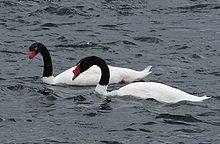
Black Necked Swans [15]
The Carlos Anwandter Nature Sanctuary is one of the more well known areas that is affected by pollution. A pulp mill located 25 km upriver of the estuary has been attributed with dumping wastes into the river and thus impacting the species within the estuary. The most impacted within the estuary is the black necked swan. After the creation of the mill in the early 2000's, and by 2004 many of the swan had died off or migrated. There are a few hypotheses as to why they were becoming increasingly absent, one being that the pollutants wiped out their main source of food in the estuary, an aquatic plant, and so they were forced to migrate out of the sanctuary. Another suggests direct poisoning of the swans by high metal concentration led to the mass die offs. The pulp mill has been closed and reopened, with some still calling for its indefinite closure, and to date the end result is that only 4 birds can now be observed there where there was once a population of over 5,000.
Issues Specific to the Chilean Coastal Sea
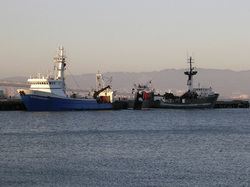
Commercial Vessels [15]
While overfishing and its governance has been questionable for some time, awareness of the commercial overexploitation of the benthic and pelagic species is increasing and as such regulations are begininning to be enforced more strictly as of late.
One of the bigger issues that Chile is currently facing within its sea is that of the aquaculture industries' practices. With the recent outbreaks of infectious salmon anemia virus (ISA), it remains to be seen just how the aquaculture industry will be affected and how their practices will change. Leading up to the detection of the disease, regulations were poorly enforced and were unable to keep up with the rate that salmon farms were increasing in number. With eradication of the entire stock being the required treatment for ISA, there is increasing pressure to move farther south into untouched waters that are still considered pristine. Along with the impacts that aquaculture has on the environment, such as nutrient loading, eutrophication, disease and escapes, there also comes the anthropogenic impacts as humans move farther south to populate the areas where there is work available. Humans alter these ecosystems in many ways. One way is by pollutants, from run off or from directly dumping wastes into the sea. Another is by limiting the flow of freshwater and nutrients to the fjord systems as they dam and divert the rivers for other uses.
One of the bigger issues that Chile is currently facing within its sea is that of the aquaculture industries' practices. With the recent outbreaks of infectious salmon anemia virus (ISA), it remains to be seen just how the aquaculture industry will be affected and how their practices will change. Leading up to the detection of the disease, regulations were poorly enforced and were unable to keep up with the rate that salmon farms were increasing in number. With eradication of the entire stock being the required treatment for ISA, there is increasing pressure to move farther south into untouched waters that are still considered pristine. Along with the impacts that aquaculture has on the environment, such as nutrient loading, eutrophication, disease and escapes, there also comes the anthropogenic impacts as humans move farther south to populate the areas where there is work available. Humans alter these ecosystems in many ways. One way is by pollutants, from run off or from directly dumping wastes into the sea. Another is by limiting the flow of freshwater and nutrients to the fjord systems as they dam and divert the rivers for other uses.
Solutions
The commercial fishing industry has a history of overexploitation due to the push for economic growth and a lack of regulations and enforcement, however, recently it has made a shift towards becoming a more sustainable industry. Increasing awareness and better oversight on the practices of both commercial and artisanal fisheries has been having a positive effect on both of these fishing industries, with catches starting to level off and some populations, such as the loco, making recoveries.
The same can not be said for the aquaculture industry. Although it was established not long after commercial fisheries took off, its growth is astounding, and the lack of oversight on the industry may be even more astonishing. With the recent collapse of the farmed salmon industry, it seems like Chile may have been focusing too much on its catch fisheries and not enough on its aquaculture industries. The full impacts of the farmed salmon collapse are not known yet, but without a new type of governance on the industry it seems doomed to head in the wrong direction, much as the catch industry was. As the desire to move further south into untouched habitats increases there also comes the consequence of altering potentially crucial environments to Chile, as not much research has been done there so the consequences remain unknown.
The most effective solution at this point in time seems to be to stop the southward spread of aquaculture until more up to date regulations can be put in place or more research can be done to determine how altering these environments may affect the bigger picture. An effective solution could be to implement the same type of strategies that were imposed upon the catch industry. Impose a quota on how much each farm can harvest, enforce existing regulations that require a certain distance between farms so as to spread out the potential harmful effects, or even possibly impose a limit on how many aquaculture farms can be in operation. Overall, better regulation, enforcement, raising awareness, and even following the same type of model that was applied to catch industries would be beneficial to Chile's aquaculture industry and may once again return them to being a top producer of farmed salmon species in the futre.
The same can not be said for the aquaculture industry. Although it was established not long after commercial fisheries took off, its growth is astounding, and the lack of oversight on the industry may be even more astonishing. With the recent collapse of the farmed salmon industry, it seems like Chile may have been focusing too much on its catch fisheries and not enough on its aquaculture industries. The full impacts of the farmed salmon collapse are not known yet, but without a new type of governance on the industry it seems doomed to head in the wrong direction, much as the catch industry was. As the desire to move further south into untouched habitats increases there also comes the consequence of altering potentially crucial environments to Chile, as not much research has been done there so the consequences remain unknown.
The most effective solution at this point in time seems to be to stop the southward spread of aquaculture until more up to date regulations can be put in place or more research can be done to determine how altering these environments may affect the bigger picture. An effective solution could be to implement the same type of strategies that were imposed upon the catch industry. Impose a quota on how much each farm can harvest, enforce existing regulations that require a certain distance between farms so as to spread out the potential harmful effects, or even possibly impose a limit on how many aquaculture farms can be in operation. Overall, better regulation, enforcement, raising awareness, and even following the same type of model that was applied to catch industries would be beneficial to Chile's aquaculture industry and may once again return them to being a top producer of farmed salmon species in the futre.
Image References
[1]http://www.mapsorama.com/topograhic-map-of-chile/
[2]http://commons.wikimedia.org/wiki/File:Peru-Chile_trench.jpg
[3]http://commons.wikimedia.org/wiki/File:Humboldt_current.jpg
[4]http://www.nma.gov.au/exhibitions/past_exhibitions/extremes/south_america/south_america_slideshow/
[5]http://eol.jsc.nasa.gov/scripts/sseop/photo.pl?mission=ISS022&roll=E&frame=90053
[6]http://drjenna.blogspot.com/2007/12/el-tereno.html
[7]http://rst.gsfc.nasa.gov/Sect17/Sect17_5a.html
[8]http://www.photolib.noaa.gov/htmls/fish3254.htm
[9]http://en.wikipedia.org/wiki/Peruvian_anchoveta
[10]http://en.wikipedia.org/wiki/Pacific_jack_mackerel
[11]http://swfsc.noaa.gov/textblock.aspx?Division=FRD&id=1119
[12]http://www.nmfs.noaa.gov/speciesid/fish_page/fish46a.html
[14]http://www.lib.noaa.gov/retiredsites/docaqua/czm.html
[15]http://www.nwfsc.noaa.gov/publications/newsletters/fishmatters/highlights2004/highlights2004.cfm
[2]http://commons.wikimedia.org/wiki/File:Peru-Chile_trench.jpg
[3]http://commons.wikimedia.org/wiki/File:Humboldt_current.jpg
[4]http://www.nma.gov.au/exhibitions/past_exhibitions/extremes/south_america/south_america_slideshow/
[5]http://eol.jsc.nasa.gov/scripts/sseop/photo.pl?mission=ISS022&roll=E&frame=90053
[6]http://drjenna.blogspot.com/2007/12/el-tereno.html
[7]http://rst.gsfc.nasa.gov/Sect17/Sect17_5a.html
[8]http://www.photolib.noaa.gov/htmls/fish3254.htm
[9]http://en.wikipedia.org/wiki/Peruvian_anchoveta
[10]http://en.wikipedia.org/wiki/Pacific_jack_mackerel
[11]http://swfsc.noaa.gov/textblock.aspx?Division=FRD&id=1119
[12]http://www.nmfs.noaa.gov/speciesid/fish_page/fish46a.html
[14]http://www.lib.noaa.gov/retiredsites/docaqua/czm.html
[15]http://www.nwfsc.noaa.gov/publications/newsletters/fishmatters/highlights2004/highlights2004.cfm
Information References
http://oceanexplorer.noaa.gov/explorations/10chile/background/habitats/habitats.html
http://en.wikipedia.org/wiki/Peru-Chile_Trench
http://en.wikipedia.org/wiki/Humboldt_Current
Castilla, JC. 2010. Fisheries in Chile: small pelagics, management, rights, and sea-zoning. Bulletin of Marine Science. 86:221-234.
http://www.sciencedirect.com/science/article/B6VC6-40SFGMT-B/2/ef8917a8e03e79a0b3240b99262d3b55#toc4
Botsford, LW, Castilla JC, Peterson CH. 1997. The management of fisheries and marine ecosystems. Science. 277:509-515.
http://www.pnas.org/content/107/39/16794.full
http://en.wikipedia.org/wiki/Peruvian_anchoveta
http://www.sciencedirect.com/science?_ob=MImg&_imagekey=B6VG5-4W26GD5-2-F&_cdi=6029&_user=2148430&_pii=S0964569109000350&_origin=article&_coverDate=05%2F31%2F2009&_sk=999479994&view=c&wchp=dGLzVlz-zSkWb&md5=c39b0a363031165ff7d2836a08904f6e&ie=/sdarticle.pdf
Fernandez, M, Castilla JC. 2005. Marine Conservation in Chile: Historical Perspective, Lessons, and Challenges. Conservation Biology. 19:1752-1762
http://en.wikipedia.org/wiki/Black-necked_Swan
http://www.icsf.net/icsf2006/ControllerServlet?handler=EXTERNALNEWS&code=getDetails&id=32725&userType=&fromPage=
Thiel, M. et al. 2007. The Humboldt Current System of Northern and Central Chile. Oceanography and Marine Biology: An Annual Review. 45:195-344
Iriarte, JL, Gonzalez HE, Nahuelhaul L. 2010. Patagonian Fjord Ecosystems in Southern Chile as a Highly Vulnerable Region: Problems and Needs. AMBIO 39:463-466
http://www.esajournals.org/doi/full/10.1890/1051-0761%282001%29011%5B1750%3AESITIS%5D2.0.CO%3B2
http://en.wikipedia.org/wiki/Peru-Chile_Trench
http://en.wikipedia.org/wiki/Humboldt_Current
Castilla, JC. 2010. Fisheries in Chile: small pelagics, management, rights, and sea-zoning. Bulletin of Marine Science. 86:221-234.
http://www.sciencedirect.com/science/article/B6VC6-40SFGMT-B/2/ef8917a8e03e79a0b3240b99262d3b55#toc4
Botsford, LW, Castilla JC, Peterson CH. 1997. The management of fisheries and marine ecosystems. Science. 277:509-515.
http://www.pnas.org/content/107/39/16794.full
http://en.wikipedia.org/wiki/Peruvian_anchoveta
http://www.sciencedirect.com/science?_ob=MImg&_imagekey=B6VG5-4W26GD5-2-F&_cdi=6029&_user=2148430&_pii=S0964569109000350&_origin=article&_coverDate=05%2F31%2F2009&_sk=999479994&view=c&wchp=dGLzVlz-zSkWb&md5=c39b0a363031165ff7d2836a08904f6e&ie=/sdarticle.pdf
Fernandez, M, Castilla JC. 2005. Marine Conservation in Chile: Historical Perspective, Lessons, and Challenges. Conservation Biology. 19:1752-1762
http://en.wikipedia.org/wiki/Black-necked_Swan
http://www.icsf.net/icsf2006/ControllerServlet?handler=EXTERNALNEWS&code=getDetails&id=32725&userType=&fromPage=
Thiel, M. et al. 2007. The Humboldt Current System of Northern and Central Chile. Oceanography and Marine Biology: An Annual Review. 45:195-344
Iriarte, JL, Gonzalez HE, Nahuelhaul L. 2010. Patagonian Fjord Ecosystems in Southern Chile as a Highly Vulnerable Region: Problems and Needs. AMBIO 39:463-466
http://www.esajournals.org/doi/full/10.1890/1051-0761%282001%29011%5B1750%3AESITIS%5D2.0.CO%3B2
